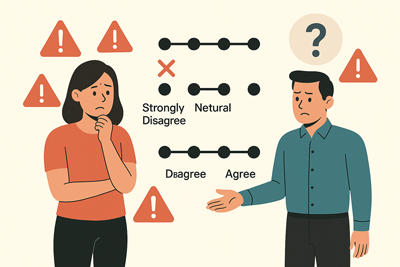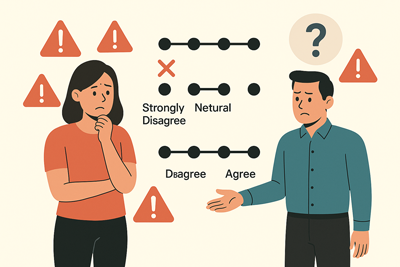Semantic Differential Scale vs Likert Scale — Which Is Best for Your Survey?
 In the quest to understand people’s opinions, feelings, and preferences, survey design is a battlefield where nuance, precision, and clarity can determine the success or failure of your results. Among the many choices researchers must make, one of the most consequential is how to structure the questions. Two of the most widely used methods for measuring attitudes and perceptions are the Semantic Differential Scale and the Likert Scale. Though often used interchangeably, these two approaches are distinct in form, purpose, and the kinds of insights they yield. This raises a critical question for any researcher, marketer, or UX designer: Which is best for your survey?
In the quest to understand people’s opinions, feelings, and preferences, survey design is a battlefield where nuance, precision, and clarity can determine the success or failure of your results. Among the many choices researchers must make, one of the most consequential is how to structure the questions. Two of the most widely used methods for measuring attitudes and perceptions are the Semantic Differential Scale and the Likert Scale. Though often used interchangeably, these two approaches are distinct in form, purpose, and the kinds of insights they yield. This raises a critical question for any researcher, marketer, or UX designer: Which is best for your survey?
Understanding the Likert Scale: Measuring Agreement in Gradients
The Likert Scale, developed in 1932 by American social psychologist Rensis Likert, is one of the most recognizable question formats in modern surveys. Its power lies in its simplicity. Respondents are presented with a statement and asked to indicate their level of agreement, usually on a scale ranging from "Strongly Disagree" to "Strongly Agree." The scale typically includes five or seven points, although variations with even-numbered options (which force a non-neutral stance) are also common.
For instance, if a company wants to measure customer satisfaction with a product, they might pose the statement, “The product met my expectations,” and allow respondents to agree or disagree to varying degrees. This format is particularly effective for measuring attitudes that align along a continuum—such as satisfaction, confidence, importance, or frequency. It allows researchers to quantify subjective experiences and then aggregate, compare, or track changes over time.
The Likert Scale is also relatively easy to design and analyze. Because responses are consistent across questions, data can be easily averaged and converted into numerical indicators. However, its strength in structure can also be a weakness: it risks reducing complex emotions or abstract judgments into a simple binary of agreement or disagreement.
The Semantic Differential Scale: Capturing the Shape of Attitudes
If the Likert Scale excels at capturing how much people agree with a statement, the Semantic Differential Scale dives into how people feel about something across multiple dimensions. Created by psychologist Charles Osgood in the 1950s, this scale presents respondents with a pair of bipolar adjectives—such as “efficient” and “inefficient”—and asks them to rate a subject along a continuum between them. Typically, the scale spans seven points, with the two extremes placed at opposite ends.
Imagine asking someone to evaluate a new electric vehicle. Instead of saying whether they “agree” that the car is innovative, a Semantic Differential item might ask them to rate the car from “Old-fashioned” to “Innovative.” Other pairs might include “Reliable – Unreliable,” “Fun – Boring,” or “Expensive – Affordable.” This format does not ask respondents to agree with a particular statement but rather invites them to assess the connotative meaning of a concept.
Unlike the Likert Scale, which is based on statements, the Semantic Differential Scale operates on oppositional word pairs that expose the nuances in how people conceptualize and emotionally respond to ideas, products, or experiences. It’s especially powerful in brand perception studies, psychological assessments, and design testing, where emotional connotation and intuitive judgments matter just as much as logical opinions.
Structural Differences
While both scales produce ordinal data, their structural differences reveal two fundamentally different philosophies of measurement. The Likert Scale assumes the researcher knows the statement that best represents what’s being measured and simply needs the respondent to validate or reject it. It works well when there's a clear, predefined evaluative stance. The Semantic Differential Scale, on the other hand, starts with opposing poles and leaves it to the respondent to situate the subject in between, allowing a more fluid, multi-faceted impression to emerge.
Moreover, while Likert items are typically unidimensional—each question addresses a single concept like satisfaction or agreement—the Semantic Differential often employs a series of adjective pairs to construct a three-dimensional representation of a subject. Osgood identified three main dimensions that such scales often uncover: evaluation (good–bad), potency (strong–weak), and activity (active–passive). This allows researchers to capture emotional and intuitive responses that may not emerge through agreement scales alone.
When and Why to Use Each Scale
The Likert Scale is ideal when measuring attitudes that can be clearly verbalized and when statistical analysis requires consistency. It’s the go-to method for employee engagement surveys, customer satisfaction assessments, political polling, and product evaluations where ease of analysis is a priority. When tracking changes over time or comparing different segments, the simplicity and standardization of Likert data shine.
The Semantic Differential Scale, in contrast, is better suited for capturing impressions, emotional reactions, and identity-related perceptions. It is often used in brand research, UX/UI testing, cultural studies, and advertising, where the goal is not to measure agreement but to map associations and emotional resonance. When subtle differences in tone, imagery, or messaging can make or break a campaign, the richness of Semantic Differential data becomes invaluable.
Design complexity is another consideration. Likert items are easier to write because they follow a consistent structure, and they’re often more familiar to respondents. Semantic Differential items, by contrast, require careful selection of adjective pairs to avoid ambiguity and ensure respondents interpret the terms similarly. This makes their development more demanding, but potentially more rewarding.
So, Which Is Better?
Ultimately, asking whether the Semantic Differential Scale is better than the Likert Scale is a bit like asking whether a camera is better than a telescope. Both are lenses, but they reveal different kinds of truth. The best choice depends on what you're trying to uncover.
If your aim is to collect structured feedback, monitor satisfaction trends, or benchmark agreement across a known set of statements, the Likert Scale is your best ally. If, however, you're exploring how people perceive, relate to, or emotionally experience a concept—especially one that is abstract or sensory—the Semantic Differential Scale offers a more textured, multidimensional view.
In fact, the most insightful surveys often use both. For example, a UX study might use Semantic Differential items to measure first impressions of a design, followed by Likert items to assess usability, satisfaction, and likelihood of recommendation.
Final thoughts
Designing an effective survey isn’t just about gathering data—it’s about asking questions in a way that brings people’s inner world into focus. The Likert Scale and the Semantic Differential Scale are not rivals so much as complementary tools. Each offers a different lens into human thought and emotion.
So the next time you set out to design a survey, don’t just reach for the familiar. Ask yourself: Am I measuring what people think, or how they feel? Am I looking for agreement, or insight into perception? The answer to that question will determine which scale belongs on your questionnaire—and how meaningful your results will be.


